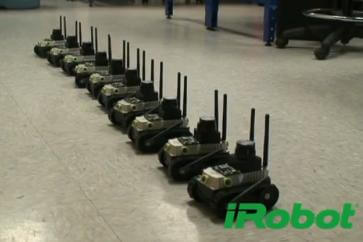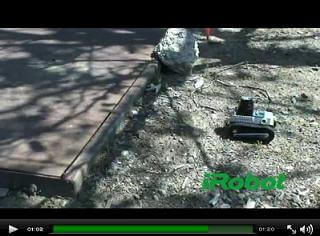
The army of the future may rely as much on WiFi as they do on weapons. To that end, iRobot has built the diminutive Ember, a mobile robotic platform that can work in a group to establish a wireless network anywhere. The pocket-sized tank is part of DARPA’s LANdroid program which aims to create a fleet of these bots, each hopefully costing less than $100. iRobot’s newest video of the Ember shows off all the cool improvements they’ve made to the bot. It now has cliff and wall detection, an optional laser scanner, four cameras, and 2 way audio. They’ve also improved its mobility and had success with mesh networking. Click on the image below to see the Ember in action on the iRobot website. This small robot may make a big impact in the future of war.
As we mentioned in previous coverage of the Ember, the small robot does more than just bring in WiFi, it can also serve as an extra pair of eyes in the field. Since last year’s demonstration for the device, iRobot has added in even more sensors. This could make the Ember into a cheap hand-held scout that any soldier can carry into battle and use to find enemy combatants, traps, or other dangers. Meanwhile, its wireless network would connect soldiers to each other and to more advanced aerial and combat drones that are already in the US Army’s arsenal. A damaged or destroyed Ember can be easily compensated for by the rest of its swarm mates, and at $100 each, chances are we’ll see these bots driven into the rough and explosive areas where they’re needed most. All that, and the little bot looks pretty cool as well. I need to get a pair of those flippers for my next car.

While the video indicates that the Ember can right itself, and handle fairly rough terrain, it doesn’t show the bot accomplishing its primary goal: autonomously establishing an optimized wireless network. DARPA’s plans for LANdroids calls for them to be able to roll out into the field and automatically position themselves to maximize signal strength in a region, no matter what kinds of walls, fallen structures, or vehicles may be in the area. It’s great that Ember has more cameras and improved mobility, but those are capabilities we’ve seen before in other robots. What we really want to see is a team of Embers zip across a simulated urban warzone and establish a network, and that same team healing the network as several of the bots are destroyed. Obviously, that’s still forthcoming.
Once the Ember fulfills its LANdroid destiny of autonomously establishing networks in warzones, it will grant unprecedented connectivity to soldiers in the field. Humans would be able to access vital data streams that may contain everything from battlefield surveillance to first aid medical guidance. With such data soldiers will be able to see where they shouldn’t be able to see, know what they haven’t been trained to know, and strike in with coordination that humans couldn’t accomplish on their own. That’s the power of robots and humans working together.
Those capabilities will be more and more important as we transition away from traditional types of military engagements. Prolonged urban ‘policing actions’ like those we’ve seen in Iraq are likely to be repeated in the future. Robots like Ember will give soldiers a better idea of what is happening around them, and connect them to the larger support structures of their units. In the end, these improvements in data management and connectivity may save more lives than deadlier weapons ever could.
[image credits: iRobot]
[source: iRobot]



